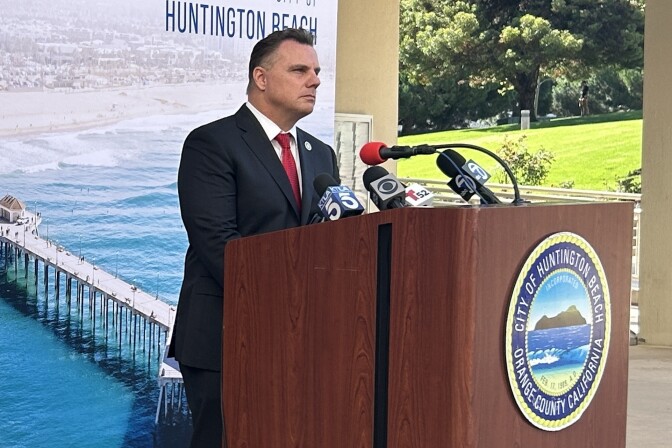A proposed compensation program from Southern California Edison for survivors of the Eaton Fire is facing criticism from a community group that says it doesn't go far enough.
The utility plans to offer direct payments to fire victims if they agree not to sue. SoCal Edison announced the program this summer and released a draft for its plan last month.
A group of fire victims gathered in Altadena on Thursday to demand Edison offer more to the thousands of people affected by the fire. The group emphasized not just the financial strain of trying to stay in their community and rebuild, but the emotional toll of prolonged displacement.
SoCal Edison faces a slew of lawsuits over the Eaton Fire, which killed 19 people and destroyed thousands of homes and businesses. The utility company has not admitted fault, but acknowledged that it's possible its equipment could be associated with the start of the fire that sparked in Eaton Canyon on Jan. 7.
On Thursday, some accused Edison of lowballing the survivors who need money the most.
"It's to pick off the most vulnerable in our community who need money the fastest," said Andrew Wessels, whose home was damaged in the Eaton Fire.
Wessels is a member of the Eaton Fire Survivors Network, an organization formed in the aftermath of the disaster that issued a 51-page report that included recommendations and critiques of SoCal Edison's current program proposal.
The report, produced with the input of more than 200 fire survivors, says the compensation program replicates the problems people are facing with their insurance providers, excludes affected people outside of the fire zone and offers less money for children than adults when compensating for emotional damages.
Joy Chen, who leads the fire survivor group, told LAist Edison "severely discounts" the toll of the fire and its aftermath on people in Altadena and the surrounding area.
" They're doing this to shield their corporate liability as opposed to enabling us to recover from their fire," she said.
Diane Castro, a spokesperson with SoCal Edison, said the utility's program wasn't yet finalized and that it would take the report into account.
" We will take what was shared today, we will take what we learned from the community workshops and we'll update the program as needed," she said.
What does Edison's proposal include?
Edison's proposed voluntary program would offer different levels of cash payment to survivors of the Eaton Fire within the fire's perimeter, depending on their circumstances. A draft of the proposal lays out figures for different types of loss, like a destroyed or damaged home, or loss of use.
There are two options for filing a claim: one "fast pay" track promises applicants a compensation offer within 90 days of submitting a completed claim, and a longer process that involves a "detailed review" of the person's economic losses. That route will take nine months to produce a settlement offer, according to Edison's draft proposal.
SoCal Edison says it will announce its compensation program sometime this fall.
Pedro Pizarro, the chief executive of Edison International, SoCal Edison’s parent company, has said the program would allow fire survivors to receive financial support faster.
“This allows the community to focus more on recovery instead of lengthy, expensive litigation,” he said in a statement.
What issues are some fire survivors raising?
In their own report, the Eaton Fire Survivors Network accused the utility of mimicking the tactics of insurance companies, and downplaying certain types of loss. The program, as written, would offer people $10,000 for each structure "with non-burn damage from smoke, soot, or ash infiltration."
Some people displaced by the fire aren't included in SoCal Edison's proposed compensation program at all. Priscilla Hernandez said she and her family live in the Hastings Ranch neighborhood of Pasadena, and have been living in alternative housing since January due to smoke damage.
Under the utility company's current plan, she said she wouldn't be eligible for a payout because she's outside the fire zone.
" When I saw that we weren't even included in the proposal, my jaw dropped," she said.
Then there's the payments for emotional distress — the money meant to compensate for "non-economic" losses like stress, despair and annoyance.
SoCal Edison's proposed program lays out dollar amounts for fire victims to correspond with their experiences, like a lost loved one, or destroyed home. Some of those amounts distinguish children from adults, offering less for kids than their parents.
Eligible residents whose homes were damaged by smoke, soot and ash will get $20,000 per adult and $5,000 per child.
That's the amount Andrew Wessels is eligible for. He recalled evacuating his two children in the middle of the night as the top of their street burned.
"To think that that trauma is $5,000," he said. "For fleeing in the middle of the night in this terrible circumstance, being out of school for weeks, being displaced into 12 homes… Are you kidding me?"












